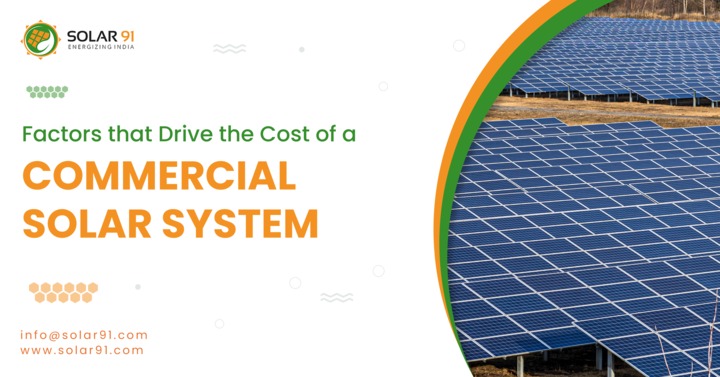Factors that Drive the Cost of a Commercial Solar System
Solar energy has grown exponentially in recent years. And for that reason, A solar photovoltaic (PV) system can be something your company is interested in purchasing to lower your monthly electric bills. If you are considering solar panels for your business, one of the first questions you likely have is, “What does a solar panel system cost?”
The cost of solar power continues to be one of the key factors determining its success even as the technology gains ground in the energy sector. The cost of solar energy is based on a number of variables. We examine the top 5 factors influencing the price of solar power while there could be other factors contributing to it.
System Size
The entire installed system cost per kilowatt of DC capacity is a crucial parameter to consider. The “DC capacity,” which is inversely proportional to the anticipated electrical output the system would provide, is typically used to size solar systems.
Solar energy’s perfect scalability is one of its alluring features. Any system size can be cost-effective, and the installation cost can be customised to match any budget, no matter how big or little. However, a limited budget can be met by simply sizing the system in accordance with the budget. Of course, the larger the system, the more energy the system will produce.
Like practically everything else, the price of solar on a $/kWdc basis decreases as system size increases. The system will normally produce power at a cheaper total cost the larger it is since there are installation efficiencies to be obtained. It’s crucial to avoid oversizing the system because excessive power will not produce the best return on investment (ROI)
Smaller solar installations are often for smaller facilities with utility rate plans that have higher blended utility rates, therefore the simple payback for both large and small systems can be excellent.
Energy Costs
Solar equipment manufacturing requires energy. The overall cost of manufacturing solar equipment is affected by the increase in fuel and power prices. Recently, this pushed the producers of materials essential for renewable energy equipment in Asia and Europe to reduce their output in order to avoid rising fuel and electricity prices. This in turn strains the already fragile material supply chain, causing more price hikes and volatility for commodities like steel, aluminium, and copper, which ultimately drives up the cost of solar as a whole.
Type of Electrical Infrastructure
The potential need for facility renovations to link the solar system to the facility is one of the largest open questions when assessing system cost. To accommodate the new solar system, outdated facilities frequently need extra AC infrastructure upgrades, which can raise expenses.
Another factor to take into account is the system’s size in relation to the current infrastructure. It is common for suggested system sizes to follow logical “steps,” whereby keeping the system below a crucial threshold can result in the most cost-effective installation by offering lower kWdc while avoiding expensive upgrades. Before any project is contracted, the installer conducts a thorough site investigation, reviewing electrical schematics to assess any potential facility enhancements. In many cases, none are needed, leading to a very cost-effective and simple installation.
Mounting Style
Rooftop and ground-mount solar installations are the two main types. As you might anticipate, rooftop systems are installed on flat or sloped rooftops, whereas ground-mount solar installations are installed on bare land. Ground-mounted systems have higher fixed project costs because they frequently require additional equipment and project planning.
Rooftop solar systems rely on the roof as the “base,” leaving the mounting system to essentially serve as a mechanical link between the roof and the solar modules, whereas ground-mounted systems depend on the mounting system to provide the full foundation for the solar system. If very large systems are wanted, ground-mounted systems may be more cost-effective because they may frequently be built bigger than rooftop systems.
Seismic Considerations
Last but not least, installing solar systems in earthquake-prone areas necessitates significant structural analysis and frequently additional supplemental anchoring. These issues are simple to resolve, but they frequently raise project prices in comparison to similar facilities installed in less seismically vulnerable regions of the nation.
Conclusion
The system size, mounting method, electrical infrastructure of the current facility, and seismic considerations are just a few of the numerous variables that might affect the price of commercial solar panels. Although these generalisations are accurate, the easiest way to determine whether they apply to your company is to simply get in touch with a highly skilled solar contractor and ask them to guide you through the process. Each project is unique, and the final design is frequently the product of an iterative process that weighs a variety of considerations.

